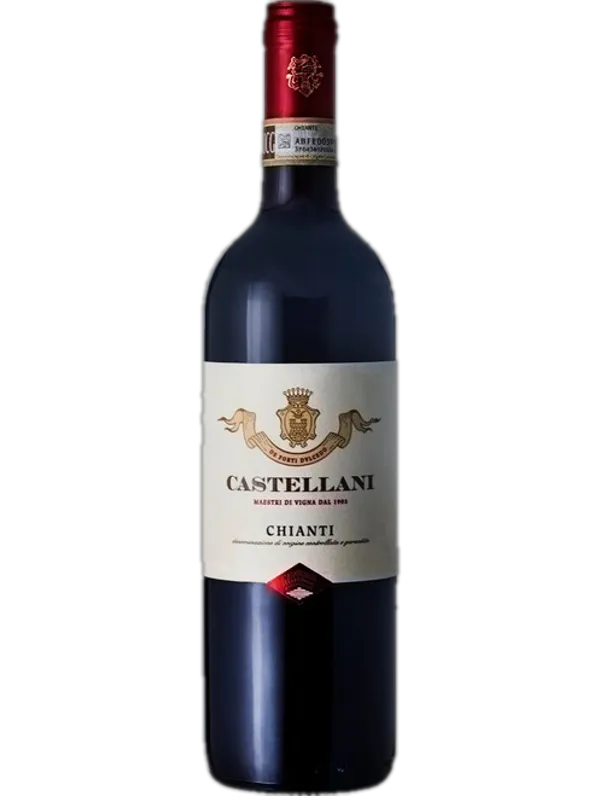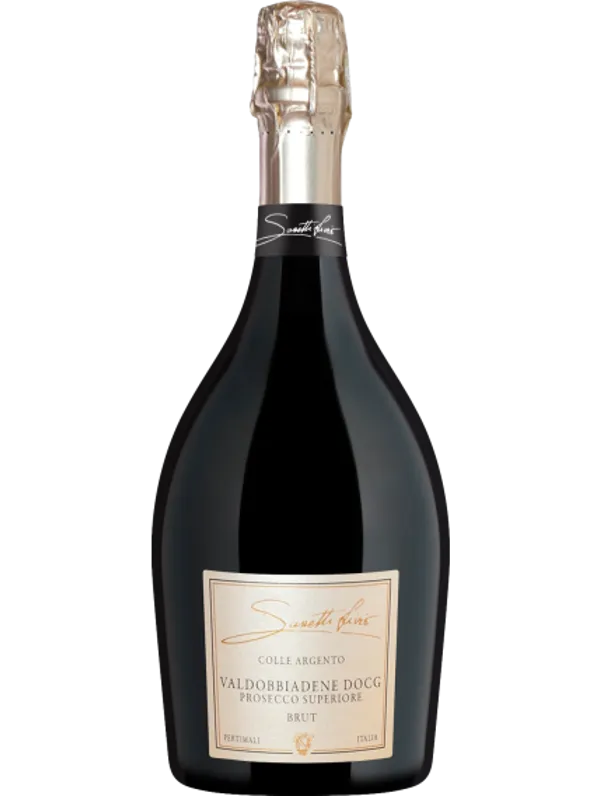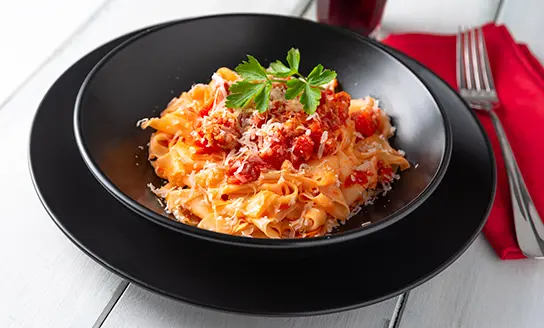Tuscany is one of the most representative Italian regions. Blessed with a vast cultural heritage, it is a region of art and history. It is renowned for its vibrant green rolling hills, Roman thermal baths and diverse coastline, also blessed with unique culinary traditions. Home to worldwide famous cities, such as Florence, Siena & Pisa, Tuscany’s offering is almost endless, making it the third most visited region in the country.
This region boasts an extraordinary winemaking heritage. Here is where the adored Sangiovese grape grows, among many other superb varieties, which have allowed Tuscany to find its way into wine lovers' hearts all over the world.
Our Choices from Tuscany

Chianti DOCG
Dry and balanced, this Chianti presents intense fruity aromas laced with violets and a cherry hint. Its light tannins evolve into velvety softness on the palate.
Read more

Querciabella Mongrana Bianco
Fresh citrus and stone fruit aromas with herbal undertones, leading to a lean, refreshing palate with marked acidity. Pairs well with summer dishes and fried calamari. Drink now or cellar up to 5 years.
Read more

Gattavecchi Vernaccia di San Gimignano
Pale yellow with aromas of ripe peaches, white flowers, and lemon zest. Zingy palate, mouthwatering acidity, and a clean, salty mineral finish. Serve chilled. Drink now or cellar up to 4 years.
Read more

Sassetti Livio Pertimali Colle Argento Valdobbiadene Prosecco Superiore Brut
Citrusy and floral Prosecco. Balanced acidity and a long finish. Pairs well with seafood and salty cheeses.
Read more

La Spinetta Il Rose di Casanova
Can cellar up to four years. Rivetti family heritage, inspired by Provence pinks but with Italian Sangiovese and Prugnolo Gentile. Citrus and berry notes, fresh palate, light-bodied, pure finish.
Read more

Ammiraglia, Aurea Gran Rose
Pale pink with distinct complexity. Exhibits grapefruit hints, followed by sweeter peach tones. Delivers a spiced finish that complements its mineral depth.
Read more

Alìe Rosé
Graceful, made with Syrah and Vermentino. Despite pale hue, offers robust pear aromas. In the mouth, it's dry and refreshingly brisk.
Read more
Tuscany's key Wine Areas
Chianti
This may be the most famous red wine region in the whole country. In Chianti, Sangiovese grapes are mainly grown, along with other Tuscan varieties such as Canaiolo, Trebbiano, and Malvasia. The region is quite large and features many other recognised viticulture zones. The most notable is the Chianti Classico region, producing the best Chianti around.
Montalcino
This region owes its name to its ancient citadel of Montalcino, in the province of Siena. Wines in this area are made primarily with Sangiovese. It is most famous for its Brunello di Montalcino. This wine must be made with only Sangiovese and aged for at least 5 years, prior to release. The result is a unique and elegant wine.
Montepulciano
This area is a popular tourist destination for its history and for its wine. Montepulciano produces very prestigious wines, like Vino Nobile di Montepulciano, which is made from a unique Sangiovese clone called Prugnolo Gentile. It is a delicious wine with an intense bouquet of prunes, cherries and violets with herbaceous and earthy notes. The town of Montepulciano should not be confused with the Montepulciano grape, which grows elsewhere in Italy (mainly Abruzzo).
Carmignano
This region is just outside the historic city of Florence, and it is just as ancient as the city. Local wine has been made in the small Carmignano area since Roman times. The region produces mainly red wines, usually from the Sangiovese grape, Canaiolo Nero and Cabernet varieties: well-structured reds, with fruit notes and a strong character, perfectly paired with beef and venison.
Bolgheri
This region is the birthplace of the Super Tuscan: a wine made with non-indigenuos grape types, mainly with a base of Bordelais grapes such as Cabernet Sauvignon and Merlot. Located in the Maremma area of Tuscany and close to the Tyrrhenian Sea, the Bolgheri area is now home of a multimedia museum of wine, the World Wine Town of Castagneto Carducci. This wine center was designed in 2017 by Dante Ferretti, Oscar-winning art director.
Food Parings

Starter: Pappa al Pomodoro
A staple Tuscan dish, a soup that consists of fresh tomatoes, bread, and extra virgin olive oil. It is a delicious result of peasant cooking.

Main course: Pappardelle al ragù di cinghiale
World-wide famous Tuscan wild boar (cinghiale) stewed with wine and herbs, cooked in a tomato-based ragù and then tossed with a ribbon-like pasta called pappardelle

Main course: Pici all’aglione
Pici is a fresh pasta, similar to thick spaghetti, unique to Tuscany. It is tossed in a rich tomato-garlic sauce using aglione, local sweet garlic.

Second course: Tagliata di Manzo
Slices of Florentine steak are served with rocket, shaved pecorino, and herbs. The Florentine breed of cattle is famous for high quality flavorful meat.

Dessert: Torta Della Nonna
Translating to ‘grandma’s cake,’ this unique Tuscan tart is filled with a delicious lemon-pine nut cream.
Tuscan food is absolutely iconic, known everywhere in the world. Its cuisine is based on la cucina povera, or peasant cooking. Several incredible dishes resulted from the Tuscans’ hardships over the years, all of which pair exceptionally well with Tuscan wines. The classic ribollita, Tuscan vegetable and bread soup pairs easily with Vernaccia di San Gimignano.
When it comes to reds, they are perfect companions to Tuscany’s high quality beef. A well-aged Brunello di Montalcino or a Vino Nobile di Montepulciano have the perfect characteristics to enhance the flavour of a bistecca alla fiorentina (Florentine steak).
FAQS
What wine is Tuscany known for?
Tuscany is most known internationally for its Chianti wines. It is also recognised for Brunello di Montalcino and Bolgheri Super Tuscans.
What grapes are grown in Tuscany?
Tuscany’s most prominent grape type is Sangiovese, the base for most regional red whines. Tuscany also grows white grapes like Vernaccia, Trebbiano, and Vermentino. In the last few decades, foreign grapes (like Cabernet Sauvignon, Syrah, and Merlot) have been planted and cultivated very successfully.
What is distinctive about Tuscan wines?
Tuscany produces some of the best wines in the world. What makes Tuscan wine so special is a combination of factors: climate, soil, know-how and the uniqueness of the indigenous grapes, the Sangiovese type above all. Wines made with Sangiovese show high levels of acidity and tannin, which are two key features for the aging process, allowing such wines to obtain incomparable flavours.
Which is the best time to visit Tuscany?
The climate in Tuscany is generally mild throughout the year, so it is always a good time to visit this beautiful region. Our personal favourite months to travel to Tuscany are: April to June, and September to November. These months offer the convenience of avoiding the heat and the huge crowds of the summer months, while still enjoying gorgeous weather.
What is unique about Tuscany compared to other parts of Italy?
Tuscany is probably the best postcard of Italy. You can get lost among great cities of art, featuring impressive Renaissance architecture. There are countless historic villages and landscapes with a unique charm. And there is no better way to end your day than having delicious Tuscan food and wine.
Want to know it all?
Tuscany: region in a nutshell
Total vineyard area:
60,286 hectaresNumber of Producers
16,000Total wine production per year:
1.9 million hectolitresNumber of DOCGs:
11Number of DOCs:
41
Tuscany's Wine History
The introduction of viticulture in Tuscany dates back to the Etruscans in the 8th century BC, an ancient civilization who was later on assimilated into the Roman Empire. The Etruscans were dedicated to their cultivation of local grapes as well as to the production of wine. Many people believe the Etruscans were the first to cultivate Sangiovese.
Over the centuries, the inhabitants of Tuscany developed their own winemaking methods, which varied noticeably between different regional areas. Today, Tuscany produces a plethora of wine styles but is especially famous for its very refined reds. The region’s climate and soil diversity is so favourable that winemakers found ideal sites to produce many foreign varieties, alongside autochthonous ones. These wines, made with non-indigenous grapes like Cabernet Sauvignon and Merlot, have been named “Super Tuscans” since the 80s.
Tuscany's Viticulture
In Tuscany, viticulture is found mostly in hilly areas, an environment favoured by grapevines. With just enough slope, grapes experience the best growing conditions, which helps obtain a high-quality wine that has both a great structure and is fairly easy to drink.
Tuscany’s climate is continental, provided with four distinctive seasons. There are no drastic temperature changes, making the overall climate fairly mild although it can get quite hot in the summer, hence winemakers plant their grapes at a higher elevation in the hills. Thankfully, the breeze from the Tuscan’s Tyrrhenian coast helps to alleviate some of the heat.
The Tuscan land is very diverse, particularly when it comes to soil. The Alberese (compact white limestone) and Galestro soils (lamellar and clayey rock) are the key to the production of Chianti, particularly popular in the province of Siena. In the southern areas closer to the coast, a calcareous-clay soil is present, especially in the Maremma territory.
Tuscany’s Top Wineries To Visit
Cantina Petra
This is a unique boutique winery located in the province of Livorno and designed by the Swiss architect Mario Botta, who also designed the San Francisco Museum of Modern Art. Known for its Super Tuscan wines, Petra represents a state of the art winery, dedicated to the production of high quality organic wines.
Capezzana
This winery is located in the village of Carmignano, provided with over 90 hectares of vineyards and 140 of olive groves. Capezzana is a family-run business whose offering is extremely vast: it works as a wedding venue, leveraging its beautiful accommodation in the form of a Tuscan estate with a unique rustic style, together with a cooking school.
Among a wide selection of whites and reds, the Capezzana Vin Santo is the real star of this winery, considered as one of the best sweet wines in the world.
Located among the Sienese hills, in the beautiful village of Montalcino, this is the only cooperative winery in the area. It accounts for over 70,000 bottles per year, specialised in the production of reds: Rosso di Montalcino DOC, Brunello di Montalcino DOCG and Brunello di Montalcino DOCG Riserva. Cantina di Montalcino stands out thanks to a unique architectural design which makes it a must-visit destination in the Montalcino area.
Best white wine grapes from Tuscany
Vermentino
Grown in coastal regions. It makes a dry and light-bodied wine, with super fresh acidity.
Vernaccia
A piece of Tuscan history responsible for the classic Vernaccia di San Gimignano.
Trebbiano
This humble grape makes easy drinking but supremely enjoyable white wines.
Best red wine grapes from Tuscany
Sangiovese
The king of Tuscan red grapes, used to make Chianti. Cherry, liquorice and earthy flavours
Canaiolo
One of Tuscany’s lesser known native grapes but a key part of traditional blends
Ciliegiolo
Its name derived from ‘ciliegia’ or ‘cherry’ in Italian. You can only guess its flavour!
